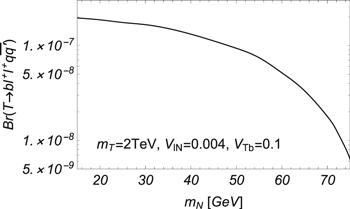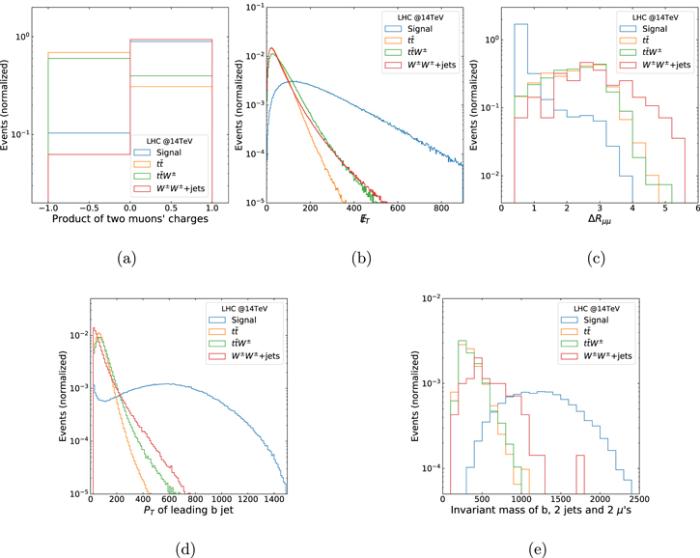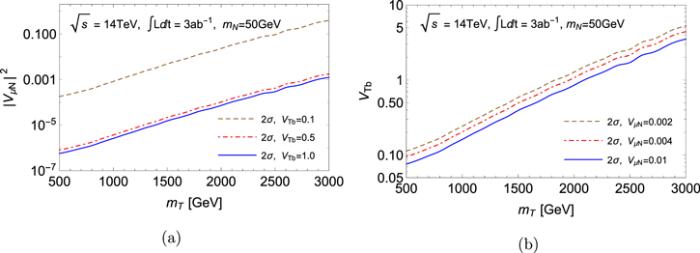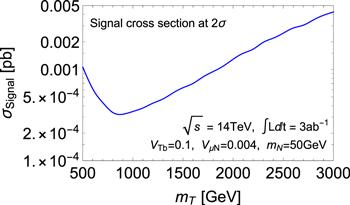 ,Physics Department and Institute of Theoretical Physics,
,Physics Department and Institute of Theoretical Physics, Received:2020-04-13Revised:2020-05-12Accepted:2020-05-27Online:2020-09-16

Abstract
Keywords:
PDF (600KB)MetadataMetricsRelated articlesExportEndNote|Ris|BibtexFavorite
Cite this article
Hang Zhou, Ning Liu. Probing vector-like top partner from same-sign dilepton events at the LHC. Communications in Theoretical Physics, 2020, 72(10): 105201- doi:10.1088/1572-9494/aba245
1. Introduction
The standard model (SM) has been a successful low-energy effective theory in describing microscopic phenomena and was completed by the discovery of the Higgs boson in 2012 at the LHC. However, a theory beyond the SM (BSM) is necessary from both theoretical and experimental points of view, one of which is the so-called naturalness problem. With the mass of the observed scalar (∼125 GeV) being comparable to the electroweak scale (∼102 GeV), the naturalness arguments require some mechanism or symmetries to suppress or cancel out the large quadratic divergence when considering loop corrections from heavy particles, such as the SM top quark, which can lead the Higgs mass up to the Planck scale (∼1019 GeV) instead of the electroweak one. Many BSM models, such as the little Higgs models [1, 2] and composite Higgs models [3-6], have been proposed to solve this problem by introducing a spontaneously broken global symmetry, leading the Higgs boson to be a pseudo Goldstone boson. In these BSM models, vector-like top partners (VLTs), usually referred to as T, are predicted. VLTs are color-triplet fermions but with the left- and right-handed components transforming in the same way under the gauge group SU(2)⨂U(1). These new particles have been searched for at hadron colliders, where they can be produced both singly and in pairs, with subsequent decays into an SM quark and a gauge boson or Higgs boson [7-16]. Searches at the LHC for VLTs have been performed and presented by the ATLAS and CMS collaborations with the lower mass bounds on T reaching up to about $740\sim 1370\,\mathrm{GeV}$, depending on the SU(2) multiplets they belong to and different branching fractions assumed [17, 18].Another motivation for BSM is the observation of neutrino oscillation in solar, atmospheric, reactor and accelerator experiments, which implies that neutrinos of three flavors are mixed and have tiny masses (∼sub-eV) [19]. Various schemes have been proposed to include neutrino masses in the SM, among which the most popular one is the so-called seesaw mechanism [20-30], since it not only generates neutrino mass in an elegant way, but also connects the observed baryon asymmetry in the Universe (BAU) and the origin of neutrino mass through leptogenesis [31-41]. Some variations of the seesaw mechanism can also accommodate dark matter candidates [42-45]. Among several seesaw mechanisms, the type-I seesaw [20-23] in a straightforward way introduces three singlet right-handed (RH) neutrinos (NRα), leading to Dirac mass terms as well as the RH Majorana mass terms. Consideration of both mass terms can generate sub-eV Majorana neutrino masses if the RH Majorana mass is set at ∼1014 GeV. Neutrino mass generation via the seesaw mechanism comes with violation of lepton number (LNV) by Δ L=2, which may be used on experiments as a sign for the Majorana nature of neutrinos. Many experiments and tests on the nature and properties of neutrinos are already in progress, such as the search for neutrinoless double beta decay (0νββ) [46, 47], as well as other LNV processes including rare τ decays, meson decays and hyperon decays [48-53]. However, the Δ L=2 processes are suppressed either by a factor of ${m}_{\nu }^{2}/{m}_{W}^{2}$ due to the smallness of the light neutrino mass mν, or by a factor of $| {V}_{\alpha m}{V}_{\beta m}{| }^{2}$ due to the small mixings, depending on whether the exchanged neutrino is light or heavy compared to the scale of the LNV processes [54]. Fortunately, the LNV processes may be enhanced substantially as a result of resonant production of heavy neutrinos, if the heavy neutrino mass can be kinematically accessible (below TeV) as in some low-scale type-I seesaw scenarios [55-64], which may be produced directly at collider experiments and searched for [54, 65-75]. An upper bound has been given by the LEP experiments on the mixings $| {V}_{{eN},\mu N}{| }^{2}\lt { \mathcal O }({10}^{-5})$ for a heavy neutrino mass of (80, 205) GeV [76]. CMS broadened the mass range to (20, 1600) GeV and put a similar limit as $| {V}_{{eN},\mu N}{| }^{2}\lt { \mathcal O }({10}^{-5})$ [77, 78].
To solve the above two problems of naturalness and neutrino oscillation, models have been proposed to incorporate neutrino masses into some scenarios with the VLTs, such as ones that include lepton-number violation between the scalar triplet and lepton doublet within the Littlest Higgs scenario [79], as well as other Little Higgs [80-90], Composite Higgs [91-95], Top Seesaw [96-98], Higgs Inflation models [99], etc [100, 101]. A common feature of these new models is that VLTs and heavy Majorana neutrinos are predicted, which leads to a new decay mode of VLT through the mediation of heavy Majorana neutrinos. Taking into account that VLTs and heavy Majorana neutrinos in low-energy type-I seesaw models are both within the search abilities at the LHC, in a model-independent way, we propose in this paper a search strategy for the above new decay channel of the VLT. There are some traditional ways to search for the vector-like top partner at the LHC, such as $T\to b\,{jj}$. These searches have been performed [17, 18] and exclude the top partner mass up to 740∼1370 GeV. In this work, we will investigate the process $T\to b\,{{\ell }}^{+}{{\ell }}^{+}{jj}$, which can be used to probe the top partner and to test the seesaw mechanism simultaneously at the LHC. In a scenario that incorporates three right-handed Majorana neutrinos and a top partner T (+2/3 electrically charged and SU(2) singlet), we demonstrate that with the heavy Majorana neutrinos at the GeV scale, the new decay mode of T can be probed at the LHC by searching for a signal of same-sign dileptons [102], which has also been utilized in a phenomenological study on a topcolor-assisted technicolor model [103] and rare B decay [104]. In section
2. Effective Lagrangian and the new decay mode of top partner
Without losing generality, we will adopt the effective interaction method to perform a phenomenological study in the following sections. The relevant interaction between a singlet top partner and W boson is given by,Introduction of interaction terms equations (
Figure 1.
 New window|Download| PPT slide
New window|Download| PPT slideFigure 1.Feynman diagrams of the top partner decay $T\to b\,{{\ell }}^{+}{{\ell }}^{+}q\bar{q^{\prime} }$ including t- and u-channels.
Figure 2.
 New window|Download| PPT slide
New window|Download| PPT slideFigure 2.Branching ratio of the top partner decay $T\to b\,{{\ell }}^{+}{{\ell }}^{+}q\bar{q^{\prime} }$, with respect to the heavy Majorana neutrino mass. $\mathrm{Br}(T\to {{bW}}^{+})=50 \% $ is assumed.
3. Search at the LHC
In the scenario we introduced in the last section, the SU(2) singlet top partner can be produced in pairs via QCD processes at the LHC, and then goes through a rare decay mediated by the heavy Majorana neutrino. If one of the paired VLTs goes through the rare decay $T\to b\,{{\ell }}^{+}{{\ell }}^{+}{jj}$ and the other decays into hadrons $\bar{T}\to \bar{b}\,{W}^{-}\to b\,{jj}$, then we have the distinct signal at the hadronic environment of the LHC as a same-sign dilepton with multi-jets including two b-tagged ones:For the signal processes (
Monte Carlo simulations are performed for both the signal (
We present the distributions of kinematic variables for signal and the SM background processes at the 14 TeV LHC in figure 3, including the product of charges of the final dimuon (figure 3(a)), missing transverse energy ${{/}\!\!\!\!{E}}_{T}$ (figure 3(b)), the relative distance between the final dimuon ${\rm{\Delta }}{R}_{\mu \mu }$ (figure 3(c)) and the transverse momentum of the leading b-jet (figure 3(d)). Figure 3(e) is the distribution of ${m}_{b2\mu 2j}$, the invariant mass reconstructed from the final two muons, a leading b-jet and two jets. It can be seen from figure 3(a) that the charges of final dimuon for the backgrounds $t\bar{t}$ and $t\bar{t}\,{W}^{\pm }$ tend to be opposite, compared with the signal. The distribution of missing transverse energy for the signal is more flat than that for the backgrounds and more signal events are found in the range of a large ${{/}\!\!\!\!{E}}_{T}$ (100 GeV∼900 GeV). Intuitively there are no neutrinos present in the final states of signal and hence signal events tend to have smaller ${{/}\!\!\!\!{E}}_{T}$ compared with the backgrounds, in which neutrinos from W decay constitute much of the missing transverse energy. However, note that it is the jets after parton-showering that arrive at the detectors, rather than the partonic final states. b\$\bar{b}$ quarks from the signal (
Figure 3.
 New window|Download| PPT slide
New window|Download| PPT slideFigure 3.Kinematic distributions of the signal ${pp}\to {\mu }^{\pm }{\mu }^{\pm }+2b+4j$ and the SM backgrounds $t\bar{t}$, $t\bar{t}{W}^{\pm }$, ${W}^{\pm }{W}^{\pm }$+jets at the 14 TeV LHC. The benchmark point is chosen as mT=2 TeV, mN=50 GeV, VTb=0.1, ${V}_{\mu N}=1.0$.
Based on the above analysis, we apply the following kinematic cuts to the events to distinguish a signal from the SM backgrounds. Cut 1: a same-sign muons is required with each of them satisfying ${p}_{T}(\mu )\gt 10\,\mathrm{GeV}$ and $| \eta (\mu )| \lt 2.8$.
Cut 2: we demand at least 6 jets in the final states with each of them having pT(j)>15 GeV and $| \eta (j)| \lt 3.0$.
Cut 3: a large missing transverse energy is required as ${{/}\!\!\!\!{E}}_{T}\gt 180\,\mathrm{GeV}$.
Cut 4: the relative distance is also required for the dilepton separation as $0.4\lt {\rm{\Delta }}{R}_{\mu \mu }\lt 1.2$, for jets separation as ${\rm{\Delta }}{R}_{{jj}}\gt 0.4$ and for jet-lepton separation as ${\rm{\Delta }}{R}_{\mu j}\gt 0.4$.
Cut 5: among the final jets, at least one of them is required to be a b-jet. And the leading b-jet should have pT>280 GeV.
Cut 6: the invariant mass ${m}_{b2\mu 2j}$ clustering the decay products of T rare decay is required to be larger than 800 GeV.
With the above cuts applied, we present in table 1 the cutflow of cross sections for signal and the SM backgrounds at the 14 TeV LHC. Among the three kinds of SM backgrounds, we can see from table 1 that the dominant one are the $t\bar{t}$ events. The first two cuts on numbers of final same-sign muons and jets can suppress the main backgrounds to the same order as the signal. Then the large ${{/}\!\!\!\!{E}}_{T}$ requirement can cut about 95% SM backgrounds while keeping 40% signal events that have survived from the first two steps of cuts. The final three cuts can effectively remove the $t\bar{t}$ and WW+jets events while leaving the $t\bar{t}{W}^{\pm }$ to an almost negligible level (about 4 orders smaller than the signal). Through the above event selection, we can reach an effective probe towards the parameter space in the present scenario.
Table 1.
Table 1.Cutflow of cross sections for the signal process ${pp}\to {\mu }^{\pm }{\mu }^{\pm }+2b+4j$ and the SM background processes ${pp}\to t\bar{t},t\bar{t}{W}^{\pm },{WW}$+jets at the 14 TeV LHC. The cross sections are in the unit of pb. The benchmark point is the same as in figure
| $t\bar{t}$ | $t\bar{t}\,{W}^{\pm }$ | WW+jets | signal | |
|---|---|---|---|---|
| Cut 1: same-sign dimuon | 8.24 | 2.00×10−2 | 1.77×10−3 | 0.590 |
| Cut 2: at least 6 jets | 0.832 | 3.55×10−3 | 1.10×10−4 | 0.268 |
| Cut 3: ${{/}\!\!\!\!{E}}_{T}\gt 180\,\mathrm{GeV}$ | 3.88×10−2 | 3.19×10−4 | 2.24×10−5 | 0.116 |
| Cut 4: on relative distance | 9.00×10−3 | 6.31×10−5 | 1.74×10−6 | 9.22×10−2 |
| Cut 5: at least 1 b-jet(pT>280 GeV) | 4.91×10−4 | 7.24×10−6 | 0 | 4.87×10−2 |
| Cut 6: mb2μ2j>800 GeV | 0 | 4.13×10−6 | 0 | 3.95×10−2 |
New window|CSV
We present in figure 4 the exclusion bounds at 2σ on the signal ${pp}\to T\bar{T}\to {\mu }^{\pm }{\mu }^{\pm }+b\bar{b}+4j$, where the statistical significance is calculated using the formula
Figure 4.
 New window|Download| PPT slide
New window|Download| PPT slideFigure 4.Contours of 2σ exclusion limits on the signal ${pp}\to T\bar{T}\to {\mu }^{\pm }{\mu }^{\pm }+b\bar{b}+4j$ at the 14 TeV LHC, with integrated luminosity of 3 ab−1. Systematic uncertainty β is taken as 5%. (a) Plotted on the plane of $| {V}_{\mu N}{| }^{2}$ versus mT and (b) on the plane of VTb versus mT.
Figure 5.
 New window|Download| PPT slide
New window|Download| PPT slideFigure 5.2σ exclusion on the cross sections of signal ${pp}\to T\bar{T}\to {\mu }^{\pm }{\mu }^{\pm }+b\bar{b}+4j$ with respect to the top partner mass at the 14 TeV LHC.
It should be noted that we have not considered pileup effects in our discussion, which is important for a fully realistic simulation and needs proper removal techniques [115-117]. However, the pileup effects can be limited on our results since the event-selection is based on a pair of hard same-sign leptons.
4. Conclusion
In this paper, we investigate the observability for the rare decay of a singlet top partner in a model-independent scenario that combines the low-energy type-I seesaw and a vector-like singlet top partner. We present a search strategy at the 14 TeV LHC for a distinguishable signal with a same-sign dilepton plus multiple jets. In a kinematically accessible mass range of the heavy Majorana neutrino (we choose mN=50 GeV as a benchmark point), the detector-level simulation at the 14 TeV LHC with integrated luminosity of 3 ab−1 shows that, the μ-flavor mixing with the heavy Majorana neutrino $| {V}_{\mu N}{| }^{2}\gt 7.6\times {10}^{-6}$ can be excluded at 2σ for VTb ≲ 1.0 and mT∼1.3 TeV. The coupling between the singlet top partner and the SM b quark VTb>0.35 can be excluded at 2σ for ${V}_{\mu N}=0.004$ and mT∼1.3 TeV. It is then concluded that in a kinematically accessible mass range of the heavy Majorana neutrino, searching at the LHC for the rare decay of a singlet top partner mediated by the heavy Majorana neutrino can be promising through the same-sign dilepton signal.Acknowledgments
This work is supported by the National Natural Science Foundation of China (NNSFC) under grant Nos. 11847208 and 11705093, as well as the Jiangsu Planned Projects for Postdoctoral Research Funds under grant No. 2019K197.Reference By original order
By published year
By cited within times
By Impact factor
DOI:10.1103/PhysRevD.69.075002 [Cited within: 1]
DOI:10.1007/JHEP01(2013)164 [Cited within: 1]
DOI:10.1016/0550-3213(85)90221-4 [Cited within: 1]
DOI:10.1016/S0550-3213(05)80021-5
DOI:10.1103/PhysRevD.75.055014
DOI:10.1088/1126-6708/2007/05/074 [Cited within: 1]
DOI:10.1016/S0370-2693(00)01071-6 [Cited within: 1]
DOI:10.1088/1126-6708/2000/09/011
DOI:10.1088/1126-6708/2009/11/030
DOI:10.1103/PhysRevD.96.015028
DOI:10.1016/j.physletb.2019.02.016
DOI:10.1016/j.nuclphysb.2014.11.021
DOI:10.1016/j.physletb.2015.12.066
DOI:10.1088/1674-1137/42/10/103102
DOI:10.1103/PhysRevD.100.015025
DOI:10.1088/0253-6102/53/6/28 [Cited within: 1]
DOI:10.1103/PhysRevLett.121.211801 [Cited within: 2]
DOI:10.1103/PhysRevD.100.072001 [Cited within: 2]
DOI:10.1103/PhysRevD.98.030001 [Cited within: 1]
DOI:10.1016/0370-2693(77)90435-X [Cited within: 2]
DOI:10.1103/PhysRevLett.44.912
DOI:10.1103/PhysRevD.22.2227 [Cited within: 1]
DOI:10.1103/PhysRevLett.43.1566
DOI:10.1016/0370-2693(80)90825-4
DOI:10.1103/PhysRevD.22.2860
DOI:10.1016/0550-3213(81)90354-0
DOI:10.1103/PhysRevD.23.165
DOI:10.1007/BF01415558
DOI:10.1103/PhysRevLett.81.1171 [Cited within: 1]
DOI:10.1016/0370-2693(86)91126-3 [Cited within: 1]
DOI:10.1016/0370-2693(85)91028-7
DOI:10.1142/S0217732386000683
DOI:10.1103/PhysRevD.45.455
DOI:10.1103/PhysRevD.46.5331
DOI:10.1016/0370-2693(94)01555-Q
DOI:10.1016/0370-2693(96)00817-9
DOI:10.1103/PhysRevD.56.5431
DOI:10.1103/PhysRevLett.80.5716
DOI:10.1016/j.physletb.2003.11.061
DOI:10.1016/j.physletb.2019.135118 [Cited within: 1]
DOI:10.1103/PhysRevD.73.077301 [Cited within: 1]
DOI:10.1103/PhysRevLett.115.011801
DOI:10.1103/PhysRevD.101.015006
DOI:10.1088/1475-7516/2017/01/030 [Cited within: 1]
DOI:10.1103/PhysRev.56.1184 [Cited within: 1]
DOI:10.1143/PTPS.83.1 [Cited within: 1]
DOI:10.1103/PhysRevD.18.3412 [Cited within: 1]
DOI:10.1103/PhysRevD.30.1488
DOI:10.1016/S0370-2693(00)01134-5
DOI:10.1007/s100520100702
DOI:10.1103/PhysRevD.46.R892
DOI:10.1016/S0370-2693(03)00773-1 [Cited within: 1]
DOI:10.1088/1126-6708/2009/05/030 [Cited within: 2]
DOI:10.1016/j.physletb.2005.09.070 [Cited within: 1]
DOI:10.1016/j.physletb.2005.06.020
DOI:10.1088/1126-6708/2007/01/091
DOI:10.1088/1126-6708/2007/01/091
DOI:10.1016/j.physletb.2006.05.067
DOI:10.1143/PTPS.180.112
DOI:10.1007/JHEP09(2010)108
DOI:10.1103/PhysRevD.84.033002
DOI:10.1155/2014/831598
DOI:10.1016/j.nuclphysb.2017.12.016
DOI:10.1103/PhysRevD.99.015025 [Cited within: 1]
DOI:10.1103/PhysRevD.75.013003 [Cited within: 1]
DOI:10.1103/PhysRevD.84.013005
DOI:10.1103/PhysRevD.76.055011
DOI:10.1103/PhysRevD.76.073005
DOI:10.1103/PhysRevD.80.073012
DOI:10.1103/PhysRevLett.97.171804
DOI:10.1103/PhysRevLett.112.081801
DOI:10.1088/1367-2630/17/7/075019
DOI:10.1007/JHEP12(2018)096
[Cited within: 1]
DOI:10.1007/s002880050370 [Cited within: 3]
DOI:10.1007/s002880050370 [Cited within: 3]
DOI:10.1007/JHEP01(2019)122 [Cited within: 2]
DOI:10.1103/PhysRevLett.120.221801 [Cited within: 2]
DOI:10.1103/PhysRevD.72.053007 [Cited within: 1]
DOI:10.1007/JHEP12(2019)154 [Cited within: 1]
DOI:10.1016/j.physletb.2009.03.013
DOI:10.1088/0256-307X/28/10/107305
DOI:10.1016/j.nuclphysb.2007.07.014
DOI:10.1142/S0217732306020561
DOI:10.1103/PhysRevD.73.033006
DOI:10.1016/j.physletb.2005.08.115
DOI:10.1016/j.physletb.2004.02.027 [Cited within: 1]
[Cited within: 1]
DOI:10.1140/epjc/s10052-013-2513-8
DOI:10.1007/JHEP08(2010)127
DOI:10.1088/1126-6708/2005/06/060 [Cited within: 1]
DOI:10.1103/PhysRevD.62.011702 [Cited within: 1]
DOI:10.1103/PhysRevD.65.055006
DOI:10.1016/j.physletb.2013.05.015 [Cited within: 1]
DOI:10.1088/1475-7516/2014/10/019 [Cited within: 1]
DOI:10.1103/PhysRevD.86.095011 [Cited within: 1]
DOI:10.1007/JHEP01(2013)082 [Cited within: 1]
DOI:10.1103/PhysRevD.84.074001 [Cited within: 1]
DOI:10.1088/0253-6102/55/5/21 [Cited within: 1]
DOI:10.1088/0253-6102/59/4/15 [Cited within: 1]
DOI:10.1103/PhysRevLett.120.132503 [Cited within: 2]
DOI:10.1007/JHEP07(2014)079 [Cited within: 1]
DOI:10.1016/j.nuclphysb.2012.10.003 [Cited within: 1]
DOI:10.1088/1126-6708/2006/05/026 [Cited within: 1]
DOI:10.1007/JHEP02(2014)057 [Cited within: 1]
DOI:10.1016/j.cpc.2017.08.021 [Cited within: 1]
DOI:10.1140/epjc/s10052-012-1896-2 [Cited within: 1]
DOI:10.1088/1126-6708/2008/04/063 [Cited within: 1]
DOI:10.1016/j.cpc.2014.06.021 [Cited within: 1]
DOI:10.1007/JHEP06(2015)184 [Cited within: 1]
DOI:10.1016/j.physletb.2007.09.077 [Cited within: 1]
DOI:10.1007/JHEP06(2014)092
DOI:10.1103/PhysRevD.90.065020 [Cited within: 1]
